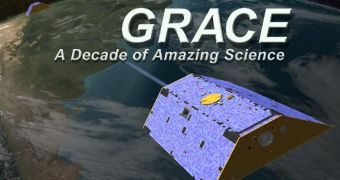For more than 10 years, the two spacecraft making up the GRACE mission have been defying and redefining gravity. A decade after their launch, they are still going strong, producing breakthroughs in our understanding of how our planet works.
The Gravity Recovery and Climate Experiment is a collaboration between the American space agency and the German Aerospace Center (DLR). Its primary mission it to help researchers understand how our planet's gravitational pull works, and how it varies with distance.
Originally, the spacecraft duo was supposed to conduct a 3- to 5-year mission, but it performed so well that officials at the two organizations decided to support it further. In retrospect, this was a good decision, since the probes more than made up for the extra cash in scientific return.
Even all these years later, GRACE is perfectly capable of making detailed measurements of Earth's gravity field. The satellites were launched on March 17, 2002, from the Plesetsk Cosmodrome, in Russia. They were carried to orbit aboard a Rockot delivery system.
Once they arrived in orbit, the two spacecraft underwent a testing and commissioning phase, after which they began their science mission. One of their main roles is to determine how different areas of Earth's crust influence the planet's gravitational pull at that location.
For example, a mountain sitting atop an oceanic plate would add extra weight to that area, therefore increasing its gravitational pull. Conversely, a simple, low-lying plain on a continental plate would exert much less of a pull on the satellites.
By flying in formation and constantly measuring the distances between each other, the GRACE satellites are able to determine when they are flying above an area of more intense gravity. These measurements are then converted into high-resolution maps of our planet's gravitational pull.
In order to ensure the most precise measurements possible, the mission uses a combination of GPS data and a microwave ranging system. The probes themselves, developed by experts at the NASA Jet Propulsion Laboratory, in Pasadena, California, fly about 220 kilometers (137 miles) apart.
“GRACE essentially demonstrated a new form of remote sensing for climate research that has turned out even better than we hoped,” JPL GRACE project scientist Michael Watkins explains.
“We realized early on in the design of GRACE that we could measure the gravity field well enough to observe the critical indicators of climate change – sea level rise and polar ice melt,” the expert adds.
Given the important contributions that GRACE has made to our understanding of the planet, mission controllers at NASA and DLR decided in June 2010 to extend the mission's life time until at least 2015.

 14 DAY TRIAL //
14 DAY TRIAL //